All Exams >
CLAT >
4 Months Preparation Course for CLAT UG >
All Questions
All questions of Mensuration for CLAT Exam
A 5 cubic centimeter cube is painted on all its side. If it is sliced into 1 cubic centimer cubes, how many 1 cubic centimeter cubes will have exactly one of their sides painted?- a)9
- b)61
- c)98
- d)54
Correct answer is option 'D'. Can you explain this answer?
A 5 cubic centimeter cube is painted on all its side. If it is sliced into 1 cubic centimer cubes, how many 1 cubic centimeter cubes will have exactly one of their sides painted?
a)
9
b)
61
c)
98
d)
54

|
Hridoy Desai answered |
When a 5 cc cube is sliced into 1 cc cubes, we will get 5*5*5 = 125 1 cc cubes.
In each side of the larger cube, the smaller cubes on the edges will have more than one of their sides painted.
Therefore, the cubes which are not on the edge of the larger cube and that lie on the facing sides of the larger cube will have exactly one side painted.
In each face of the larger cube, there will be 5*5 = 25 cubes. Of these, there will be 16 cubes on the edge and 3*3 = 9 cubes which are not on the edge.
Therefore, there will be 9 1-cc cubes per face that will have exactly one of their sides painted.
In total, there will be 9*6 = 54 such cubes.
In each side of the larger cube, the smaller cubes on the edges will have more than one of their sides painted.
Therefore, the cubes which are not on the edge of the larger cube and that lie on the facing sides of the larger cube will have exactly one side painted.
In each face of the larger cube, there will be 5*5 = 25 cubes. Of these, there will be 16 cubes on the edge and 3*3 = 9 cubes which are not on the edge.
Therefore, there will be 9 1-cc cubes per face that will have exactly one of their sides painted.
In total, there will be 9*6 = 54 such cubes.
A 5 cm cube is cut into as many 1 cm cubes as possible. What is the ratio of the surface area of the larger cube to that of the sum of the surface areas of the smaller cubes?- a)1 : 6
- b)1 : 5
- c)1 : 25
- d)1 : 125
Correct answer is option 'B'. Can you explain this answer?
A 5 cm cube is cut into as many 1 cm cubes as possible. What is the ratio of the surface area of the larger cube to that of the sum of the surface areas of the smaller cubes?
a)
1 : 6
b)
1 : 5
c)
1 : 25
d)
1 : 125

|
Snehal Banerjee answered |
The volume of the larger cube = 53 = 125 cm3.
The volume of each of the smaller cubes = 13 = 1 cm3. Therefore, one would get 125 smaller cubes.
The surface area of the larger cube = 6a2 = 6(52) = 6 * 25 = 150
The surface area of each of the smaller cubes = 6 (12) = 6.
Therefore, surface area of all of the 125, 1 cm3 cubes = 125 * 6 = 750.
Therefore, the required ratio = 150 : 750 = 1 : 5
The volume of each of the smaller cubes = 13 = 1 cm3. Therefore, one would get 125 smaller cubes.
The surface area of the larger cube = 6a2 = 6(52) = 6 * 25 = 150
The surface area of each of the smaller cubes = 6 (12) = 6.
Therefore, surface area of all of the 125, 1 cm3 cubes = 125 * 6 = 750.
Therefore, the required ratio = 150 : 750 = 1 : 5
A circular road is constructed outside a square field. The perimeter of the square field is 200 ft. If the width of the road is 7√2 ft. and cost of construction is Rs. 100 per sq. ft. Find the lowest possible cost to construct 50% of the total road.- a)Rs.70,400
- b)Rs.1,25,400
- c)Rs.1,40,800
- d)Rs.2,35,400
Correct answer is option 'B'. Can you explain this answer?
A circular road is constructed outside a square field. The perimeter of the square field is 200 ft. If the width of the road is 7√2 ft. and cost of construction is Rs. 100 per sq. ft. Find the lowest possible cost to construct 50% of the total road.
a)
Rs.70,400
b)
Rs.1,25,400
c)
Rs.1,40,800
d)
Rs.2,35,400

|
Sonal Banerjee answered |
The area of the circular road
= π ro2 - π ri2, where ro is the outer radius and ri is the inner radius.

25= 2508 sq. ft.
= π ro2 - π ri2, where ro is the outer radius and ri is the inner radius.

25= 2508 sq. ft.
If per sq. ft. cost is Rs. 100, then cost of constructing the road = 2508 × 100 = Rs.2,50,800.
Cost of constructing 50% of the road = 50% of the total cost = 250800/2 =Rs.1,25,400
Which of the following figures has the largest area?
A circle of radius √2
An equilateral triangle whose sides each have length 4
A triangle whose sides have lengths 3, 4 and 5- a)I
- b)II
- c)III
- d)I and III
Correct answer is option 'B'. Can you explain this answer?
Which of the following figures has the largest area?
A circle of radius √2
An equilateral triangle whose sides each have length 4
A triangle whose sides have lengths 3, 4 and 5
A circle of radius √2
An equilateral triangle whose sides each have length 4
A triangle whose sides have lengths 3, 4 and 5
a)
I
b)
II
c)
III
d)
I and III
|
|
Mehul Sengupta answered |
The figure with the largest area is a circle with a radius of 6 units.
The surface area of the three coterminous faces of a cuboid are 6, 15, 10 sq.cm respectively. Find the volume of the cuboid.- a)30 cc
- b)20 cc
- c)40 cc
- d)35 cc
Correct answer is option 'A'. Can you explain this answer?
The surface area of the three coterminous faces of a cuboid are 6, 15, 10 sq.cm respectively. Find the volume of the cuboid.
a)
30 cc
b)
20 cc
c)
40 cc
d)
35 cc

|
Maya Choudhury answered |
If l, b, h be the dimensions of the cuboid, then volume of the cuboid = l X b X h


The circumference of the front wheel of a cart is 30 ft long and that of the back wheel is 36 ft long. What is the distance travelled by the cart, when the front wheel has done five more revolutions than the rear wheel?- a)20 ft
- b)25 ft
- c)750 ft
- d)900 ft
Correct answer is option 'D'. Can you explain this answer?
The circumference of the front wheel of a cart is 30 ft long and that of the back wheel is 36 ft long. What is the distance travelled by the cart, when the front wheel has done five more revolutions than the rear wheel?
a)
20 ft
b)
25 ft
c)
750 ft
d)
900 ft

|
Kaavya Sarkar answered |
Understanding the Problem
To determine the distance traveled by the cart, we need to analyze the revolutions of the front and back wheels.
Wheel Circumference
- Front Wheel: 30 ft
- Back Wheel: 36 ft
Revolutions of Wheels
Let the number of revolutions made by the back wheel be \( x \).
Then, the front wheel has done \( x + 5 \) revolutions.
Distance Traveled Calculation
The distance traveled by each wheel can be calculated using the formula:
- Distance = Circumference × Number of Revolutions
For the back wheel:
- Distance (Back Wheel) = 36 ft × \( x \) = \( 36x \) ft
For the front wheel:
- Distance (Front Wheel) = 30 ft × \( (x + 5) \) = \( 30(x + 5) \) ft
Setting Distances Equal
Since the cart travels the same distance regardless of which wheel is considered, we set the distances equal:
\[ 36x = 30(x + 5) \]
Expanding the equation:
- \( 36x = 30x + 150 \)
Simplifying:
- \( 36x - 30x = 150 \)
- \( 6x = 150 \)
- \( x = 25 \)
Calculating Distance
Now, substituting \( x \) back into either distance equation:
Distance traveled by the back wheel:
- \( 36x = 36 \times 25 = 900 \) ft
Conclusion
Thus, the total distance traveled by the cart when the front wheel has done five more revolutions than the rear wheel is 900 ft. Therefore, the correct answer is option D.
To determine the distance traveled by the cart, we need to analyze the revolutions of the front and back wheels.
Wheel Circumference
- Front Wheel: 30 ft
- Back Wheel: 36 ft
Revolutions of Wheels
Let the number of revolutions made by the back wheel be \( x \).
Then, the front wheel has done \( x + 5 \) revolutions.
Distance Traveled Calculation
The distance traveled by each wheel can be calculated using the formula:
- Distance = Circumference × Number of Revolutions
For the back wheel:
- Distance (Back Wheel) = 36 ft × \( x \) = \( 36x \) ft
For the front wheel:
- Distance (Front Wheel) = 30 ft × \( (x + 5) \) = \( 30(x + 5) \) ft
Setting Distances Equal
Since the cart travels the same distance regardless of which wheel is considered, we set the distances equal:
\[ 36x = 30(x + 5) \]
Expanding the equation:
- \( 36x = 30x + 150 \)
Simplifying:
- \( 36x - 30x = 150 \)
- \( 6x = 150 \)
- \( x = 25 \)
Calculating Distance
Now, substituting \( x \) back into either distance equation:
Distance traveled by the back wheel:
- \( 36x = 36 \times 25 = 900 \) ft
Conclusion
Thus, the total distance traveled by the cart when the front wheel has done five more revolutions than the rear wheel is 900 ft. Therefore, the correct answer is option D.
A 4 cm cube is cut into 1 cm cubes. What is the percentage increase in the surface area after cutting?- a)4 %
- b)300 %
- c)75 %
- d)400 %
Correct answer is option 'B'. Can you explain this answer?
A 4 cm cube is cut into 1 cm cubes. What is the percentage increase in the surface area after cutting?
a)
4 %
b)
300 %
c)
75 %
d)
400 %

|
Kalyan Nair answered |
Volume of 4 cm cube = 64 cc. When it is cut into 1 cm cube, the volume of each of the cubes = 1cc
Hence, there will be 64 such cubes. Surface area of small cubes = 6 (12) = 6 sqcm.
Therefore, the surface area of 64 such cubes = 64 * 6 = 384 sqcm.
The surface area of the large cube = 6(42) = 6*16 = 96.
% increase
Hence, there will be 64 such cubes. Surface area of small cubes = 6 (12) = 6 sqcm.
Therefore, the surface area of 64 such cubes = 64 * 6 = 384 sqcm.
The surface area of the large cube = 6(42) = 6*16 = 96.
% increase

Ram a farmer, managed to grow shaped-watermelons inside glass cases of different shapes. The shapes he used were: a perfect cube, hemi-spherical, cuboid, cylindrical along with the normal spherical shaped watermelons. Thickness of the skin was same for all the shapes. Each of the glass cases was so designed that the total volume and the weight of the all the water-melons would be equal irrespective of the shape.
A customer wants to buy water-melon for making juice, for which the skin of the water-melon has to be peeled off, and therefore is a waste. Which shape should the customer buy?
- a)Cube
- b)Hemi - sphere
- c)Cuboid
- d)Normal spherical
Correct answer is option 'D'. Can you explain this answer?
Ram a farmer, managed to grow shaped-watermelons inside glass cases of different shapes. The shapes he used were: a perfect cube, hemi-spherical, cuboid, cylindrical along with the normal spherical shaped watermelons. Thickness of the skin was same for all the shapes. Each of the glass cases was so designed that the total volume and the weight of the all the water-melons would be equal irrespective of the shape.
A customer wants to buy water-melon for making juice, for which the skin of the water-melon has to be peeled off, and therefore is a waste. Which shape should the customer buy?
A customer wants to buy water-melon for making juice, for which the skin of the water-melon has to be peeled off, and therefore is a waste. Which shape should the customer buy?
a)
Cube
b)
Hemi - sphere
c)
Cuboid
d)
Normal spherical

|
Sanskriti Ahuja answered |
This is the kind of question that is either very easy or very difficult depending on whether you know the concept behind the question.
For a given surface area, the volume contained increases with increasing symmetry of the object. For instance, if we are to make water melons of different shapes of the same surface area, the volume will be maximum when it is made into a sphere.
The corollary is that for a given volume, the surface area will be minimum when the object is a sphere. So, the customer should opt for spherical shaped water melons if she has to minimize wastage.
For 2-dimensional object, for a given perimeter, the area increases with increasing symmetry.
Among different triangles of a given perimeter, an equilateral triangle has the largest area.
The area increases with increasing number of sides - i.e., for a given perimeter the area of a square will larger than that of an equilateral triangle; the area of a regular pentagon of a given perimeter will be larger than that of a square and so on.
Among different regular polygons of a given perimeter / circumference a circle has the largest area.
For a given surface area, the volume contained increases with increasing symmetry of the object. For instance, if we are to make water melons of different shapes of the same surface area, the volume will be maximum when it is made into a sphere.
The corollary is that for a given volume, the surface area will be minimum when the object is a sphere. So, the customer should opt for spherical shaped water melons if she has to minimize wastage.
For 2-dimensional object, for a given perimeter, the area increases with increasing symmetry.
Among different triangles of a given perimeter, an equilateral triangle has the largest area.
The area increases with increasing number of sides - i.e., for a given perimeter the area of a square will larger than that of an equilateral triangle; the area of a regular pentagon of a given perimeter will be larger than that of a square and so on.
Among different regular polygons of a given perimeter / circumference a circle has the largest area.
If each interior angle of a regular polygon is 150 degrees, then it is a/an ______________
- a)Octagon
- b)Decagon
- c)Dodecagon
- d)Tetrahedron
Correct answer is option 'C'. Can you explain this answer?
If each interior angle of a regular polygon is 150 degrees, then it is a/an ______________
a)
Octagon
b)
Decagon
c)
Dodecagon
d)
Tetrahedron

|
Devika Yadav answered |
The sum of the exterior angle and interior angle of a regular polygon is 3600.
As the measure of each interior angle is 1500, the measure of each exterior angle will be 300.
The number of sides of a regular polygon is given by the following relationship n = 360/exterior angle
As the value of each exterior angle is 300, the number of sides = 12.
As the measure of each interior angle is 1500, the measure of each exterior angle will be 300.
The number of sides of a regular polygon is given by the following relationship n = 360/exterior angle
As the value of each exterior angle is 300, the number of sides = 12.
A solid metal cylinder of 10 cm height and 14 cm diameter is melted and re-cast into two cones in the proportion of 3 : 4 (volume), keeping the height 10 cm. What would be the percentage change in the flat surface area before and after?- a)9 %
- b)16 %
- c)25%
- d)50 %
Correct answer is option 'D'. Can you explain this answer?
A solid metal cylinder of 10 cm height and 14 cm diameter is melted and re-cast into two cones in the proportion of 3 : 4 (volume), keeping the height 10 cm. What would be the percentage change in the flat surface area before and after?
a)
9 %
b)
16 %
c)
25%
d)
50 %

|
Gitanjali Kumar answered |
Change in flat surface area = 21k – 14k = 7k
% change in flat surface area 7k/14k * 100 = 50%.
% change in flat surface area 7k/14k * 100 = 50%.
If the diagonal and the area of a rectangle are 25 m and 168 m2, what is the length of the rectangle?- a)17 m
- b)31 m
- c)12 m
- d)24 m
Correct answer is option 'D'. Can you explain this answer?
If the diagonal and the area of a rectangle are 25 m and 168 m2, what is the length of the rectangle?
a)
17 m
b)
31 m
c)
12 m
d)
24 m

|
Sankar Desai answered |
The diagonal d = 25m. and area A = 168 m2.
Let 'l' be the length and 'b' be the width of the rectangle.
Therefore, l2 + b2 = d2. and lb = A
We can therefore write (l + b)2 = d2 + 2A and (l - b)2 = d2 - 2A.
Substituting and solving we get, l + b = 31 and l - b = 17. Hence l = 24 and b = 7
Let 'l' be the length and 'b' be the width of the rectangle.
Therefore, l2 + b2 = d2. and lb = A
We can therefore write (l + b)2 = d2 + 2A and (l - b)2 = d2 - 2A.
Substituting and solving we get, l + b = 31 and l - b = 17. Hence l = 24 and b = 7
Four horses are tethered at 4 corners of a square field of side 70 metres so that they can just about reach one another. The area left ungrazed by the horses is:- a)1050 sq.m
- b)3850 sq.m
- c)950 sq.m
- d)1075 sq.m
Correct answer is option 'A'. Can you explain this answer?
Four horses are tethered at 4 corners of a square field of side 70 metres so that they can just about reach one another. The area left ungrazed by the horses is:
a)
1050 sq.m
b)
3850 sq.m
c)
950 sq.m
d)
1075 sq.m
|
|
Sameer Ghoshal answered |
Solution:
Let's draw a diagram to visualize the problem:

From the diagram, we can see that the ungrazed area is made up of four triangles, one in each corner of the square field. To find the area of each triangle, we need to first find the length of the diagonal of each square formed by the horses.
Using Pythagoras' theorem, we can find the diagonal of each square:
$ \text{Diagonal of square} = \sqrt{70^2 + 70^2} = \sqrt{2}\times 70 \approx 98.99\text{ m} $
Now we can find the area of each triangle:
$ \text{Area of triangle} = \frac{1}{2}(\text{length})\times (\text{height}) $
The height of each triangle is the radius of the circle formed by the horses, which is half the diagonal of the square:
$ \text{Height of triangle} = \frac{1}{2}(\text{diagonal of square}) = \frac{1}{2}\times \sqrt{2}\times 70 \approx 49.495\text{ m} $
The length of each triangle is the distance between two horses, which is the same as the length of the side of the square:
$ \text{Length of triangle} = \text{Side of square} = 70\text{ m} $
Therefore, the area of each triangle is:
$ \text{Area of triangle} = \frac{1}{2}\times 70\times 49.495 \approx 1717.8\text{ sq.m} $
Since there are four triangles, the total ungrazed area is:
$ \text{Total ungrazed area} = 4\times \text{Area of triangle} \approx 4\times 1717.8 \approx 6871.2\text{ sq.m} $
However, we need to subtract this from the total area of the square field, which is:
$ \text{Total area of square field} = 70^2 = 4900\text{ sq.m} $
Therefore, the area left ungrazed by the horses is:
$ \text{Area left ungrazed} = \text{Total area of square field} - \text{Total ungrazed area} \approx 4900 - 6871.2 \approx 1050\text{ sq.m} $
Therefore, the correct answer is option A, 1050 sq.m.
Let's draw a diagram to visualize the problem:

From the diagram, we can see that the ungrazed area is made up of four triangles, one in each corner of the square field. To find the area of each triangle, we need to first find the length of the diagonal of each square formed by the horses.
Using Pythagoras' theorem, we can find the diagonal of each square:
$ \text{Diagonal of square} = \sqrt{70^2 + 70^2} = \sqrt{2}\times 70 \approx 98.99\text{ m} $
Now we can find the area of each triangle:
$ \text{Area of triangle} = \frac{1}{2}(\text{length})\times (\text{height}) $
The height of each triangle is the radius of the circle formed by the horses, which is half the diagonal of the square:
$ \text{Height of triangle} = \frac{1}{2}(\text{diagonal of square}) = \frac{1}{2}\times \sqrt{2}\times 70 \approx 49.495\text{ m} $
The length of each triangle is the distance between two horses, which is the same as the length of the side of the square:
$ \text{Length of triangle} = \text{Side of square} = 70\text{ m} $
Therefore, the area of each triangle is:
$ \text{Area of triangle} = \frac{1}{2}\times 70\times 49.495 \approx 1717.8\text{ sq.m} $
Since there are four triangles, the total ungrazed area is:
$ \text{Total ungrazed area} = 4\times \text{Area of triangle} \approx 4\times 1717.8 \approx 6871.2\text{ sq.m} $
However, we need to subtract this from the total area of the square field, which is:
$ \text{Total area of square field} = 70^2 = 4900\text{ sq.m} $
Therefore, the area left ungrazed by the horses is:
$ \text{Area left ungrazed} = \text{Total area of square field} - \text{Total ungrazed area} \approx 4900 - 6871.2 \approx 1050\text{ sq.m} $
Therefore, the correct answer is option A, 1050 sq.m.
The area of a square field is 24200 sq m. How long will a lady take to cross the field diagonally at the rate of 6.6 km/hr?- a)3 minutes
- b)2 minutes
- c)2.4 minutes
- d)2 minutes 40 seconds
Correct answer is option 'B'. Can you explain this answer?
The area of a square field is 24200 sq m. How long will a lady take to cross the field diagonally at the rate of 6.6 km/hr?
a)
3 minutes
b)
2 minutes
c)
2.4 minutes
d)
2 minutes 40 seconds

|
Pallavi Sharma answered |
Let ‘a’ meters be the length of a side of the square field.
Therefore, its area = a2 square meters. --- (1)
We know that the length of the diagonal ‘d’ of a square whose side is ‘a’ meters = √2---(2)
From (1) and (2), we can deduce that the square of the diagonal = d2 = 2a2

The time taken to cross a length of 220 meters while traveling at 6.6 kmph is given by
 (converting 1 km = 1000 meters and 1 hour = 60 minutes).
(converting 1 km = 1000 meters and 1 hour = 60 minutes).
Therefore, its area = a2 square meters. --- (1)
We know that the length of the diagonal ‘d’ of a square whose side is ‘a’ meters = √2---(2)
From (1) and (2), we can deduce that the square of the diagonal = d2 = 2a2

The time taken to cross a length of 220 meters while traveling at 6.6 kmph is given by
 (converting 1 km = 1000 meters and 1 hour = 60 minutes).
(converting 1 km = 1000 meters and 1 hour = 60 minutes).A regular hexagon is inscribed in a circle of radius r cm. What is the perimeter of the regular hexagon?- a)3r
- b)6r
- c)√72 r
- d)9 r
Correct answer is option 'B'. Can you explain this answer?
A regular hexagon is inscribed in a circle of radius r cm. What is the perimeter of the regular hexagon?
a)
3r
b)
6r
c)
√72 r
d)
9 r

|
Snehal Banerjee answered |
A regular hexagon comprises 6 equilateral triangles, each of them having one of their vertices at the center of the hexagon. The sides of the equilateral triangle are equal to the radius of the smallest circle inscribing the hexagon. Hence, each of the side of the hexagon is equal to the radius of the hexagon and the perimeter of the hexagon is 6r.
The figure below has been obtained by folding a rectangle. The total area of the figure (as visible) is 144 square meters. Had the rectangle not been folded, the current overlapping part would have been a square. What would have been the total area of the original unfolded rectangle?
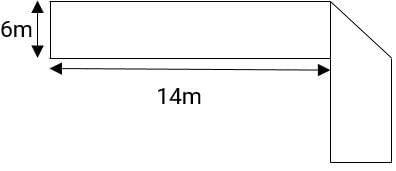
- a)128 square meters
- b)154 square meters
- c)162 square meters
- d)172 square meters
Correct answer is option 'C'. Can you explain this answer?
The figure below has been obtained by folding a rectangle. The total area of the figure (as visible) is 144 square meters. Had the rectangle not been folded, the current overlapping part would have been a square. What would have been the total area of the original unfolded rectangle?


a)
128 square meters
b)
154 square meters
c)
162 square meters
d)
172 square meters

|
Sankar Desai answered |
Folded part as shown in the first figure is a triangle - a right triangle.
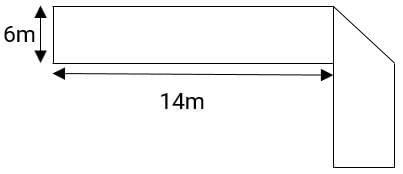

The two perpendicular sides of the right triangle measure 6m each. So, the triangle is a right isosceles triangle.
When unfolded the folded area becomes a square as shown in the following figure.


The side of the square will be the width of the larger rectangle and is therefore, 6m.
Area of the square = 6 * 6 = 36 sq.m
When folded, only the area of the right triangle gets counted.
However, when unfolded the area of square gets counted.
The square comprises two congruent right triangles.
When folded, only the area of the right triangle gets counted.
However, when unfolded the area of square gets counted.
The square comprises two congruent right triangles.
In essence, when folded only half a square is counted. When unfolded the entire square gets counted.
The area of the rectangle when unfolded = area of the rectangle when folded + area of half a square.
So area after unfolding= 144 + 18 = 162 sq.m.
So area after unfolding= 144 + 18 = 162 sq.m.
A square sheet of paper is converted into a cylinder by rolling it along its length. What is the ratio of the base radius to the side of the square?- a)

- b)

- c)

- d)

Correct answer is option 'A'. Can you explain this answer?
A square sheet of paper is converted into a cylinder by rolling it along its length. What is the ratio of the base radius to the side of the square?
a)

b)

c)

d)


|
Hridoy Desai answered |
Surface area of the cylinder = Surface area of the square 2πh = a2
Here height 'h' of the cylinder = side of the square since it is rolled along its length. 2πa = a2
Base radius r = a / 2π
Ratio of base radius to side of square =
Here height 'h' of the cylinder = side of the square since it is rolled along its length. 2πa = a2
Base radius r = a / 2π
Ratio of base radius to side of square =

If x units are added to the length of the radius of a circle, what is the number of units by which the circumference of the circle is increased?- a)x
- b)2x
- c)2πx
- d)x2
Correct answer is option 'C'. Can you explain this answer?
If x units are added to the length of the radius of a circle, what is the number of units by which the circumference of the circle is increased?
a)
x
b)
2x
c)
2πx
d)
x2

|
Sonal Banerjee answered |
Let the radius of the circle be 'r' units.
The circumference of the circle will therefore be 2πr units.
If the radius is increased by 'x' units, the new radius will be (r + x) units.
The new circumference will be
Or the circumference increases by 2πx units .
The circumference of the circle will therefore be 2πr units.
If the radius is increased by 'x' units, the new radius will be (r + x) units.
The new circumference will be

Or the circumference increases by 2πx units .
The hexagon ABCDEF is regular. That means all its sides are of the same length and all its interior angles are of the same size. Each side of the hexagon is 2 m. What is the area of the rectangle BCEF?
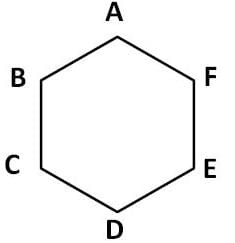
- a)4 sq.m
- b)4√3 sq.m
- c)8 sq.m
- d)4 + 4√3 sq.m
Correct answer is option 'B'. Can you explain this answer?
The hexagon ABCDEF is regular. That means all its sides are of the same length and all its interior angles are of the same size. Each side of the hexagon is 2 m. What is the area of the rectangle BCEF?


a)
4 sq.m
b)
4√3 sq.m
c)
8 sq.m
d)
4 + 4√3 sq.m

|
Maya Choudhury answered |
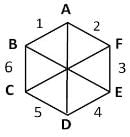
A regular hexagon comprises six equilateral triangles - each of side 2 m, the measure of the side of the regular hexagon - as shown above. The 6 triangles are numbered 1 to 6 in the figure shown above.
BX is the altitude of triangle 1 and XF is the altitude of triangle 2.
Both triangle 1 and triangle 2 are equilateral triangles.
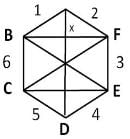
Hence, BX = XF =

Therefore, BF, the length of the rectangle = 2√3 M
Hence, the area of the rectangle BCEF = length * width = 2√3 * 2 = 4 √3 sq. m
If the sides of a triangle measure 72, 75 and 21, what is the measure of its in radius?- a)37.5
- b)24
- c)9
- d)15
Correct answer is option 'C'. Can you explain this answer?
If the sides of a triangle measure 72, 75 and 21, what is the measure of its in radius?
a)
37.5
b)
24
c)
9
d)
15

|
Tejas Gupta answered |
The sides of the triangle happen to be a Pythagorean triplet. Hence, the triangle is a right angled triangle.
For a right angled triangle,
The measure of in radius = (product of perpendicular sides) / (perimeter of triangle)
= (72 * 21) / (72 + 21 +75) = 1512 / 168 = 9
For a right angled triangle,
The measure of in radius = (product of perpendicular sides) / (perimeter of triangle)
= (72 * 21) / (72 + 21 +75) = 1512 / 168 = 9
ABCD has area equal to 28. BC is parallel to AD. BA is perpendicular to AD. If BC is 6 and AD is 8, then what is CD?
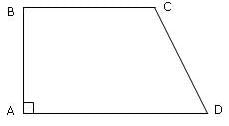
- a)2√2
- b)2√3
- c)4
- d)2√5
Correct answer is option 'D'. Can you explain this answer?
ABCD has area equal to 28. BC is parallel to AD. BA is perpendicular to AD. If BC is 6 and AD is 8, then what is CD?


a)
2√2
b)
2√3
c)
4
d)
2√5

|
Nilotpal Sen answered |
The given shape is a trapezium.
Area of a trapezium
28 =
Height = 4.
BA is perpendicular to BC and AD.
So, drop a line parallel to BA from C to meet AD at E.
CED is a right triangle with side CE measuring 4 and ED measuring 2 units.
Hence, CD, the measure of the hypotenuse =
Area of a trapezium

28 =

Height = 4.
BA is perpendicular to BC and AD.
So, drop a line parallel to BA from C to meet AD at E.
CED is a right triangle with side CE measuring 4 and ED measuring 2 units.
Hence, CD, the measure of the hypotenuse =

Chapter doubts & questions for Mensuration - 4 Months Preparation Course for CLAT UG 2025 is part of CLAT exam preparation. The chapters have been prepared according to the CLAT exam syllabus. The Chapter doubts & questions, notes, tests & MCQs are made for CLAT 2025 Exam. Find important definitions, questions, notes, meanings, examples, exercises, MCQs and online tests here.
Chapter doubts & questions of Mensuration - 4 Months Preparation Course for CLAT UG in English & Hindi are available as part of CLAT exam.
Download more important topics, notes, lectures and mock test series for CLAT Exam by signing up for free.

Contact Support
Our team is online on weekdays between 10 AM - 7 PM
Typical reply within 3 hours
|
Free Exam Preparation
at your Fingertips!
Access Free Study Material - Test Series, Structured Courses, Free Videos & Study Notes and Prepare for Your Exam With Ease

 Join the 10M+ students on EduRev
Join the 10M+ students on EduRev
|

|
Create your account for free
OR
Forgot Password
OR
Signup to see your scores
go up within 7 days!
Access 1000+ FREE Docs, Videos and Tests
Takes less than 10 seconds to signup









